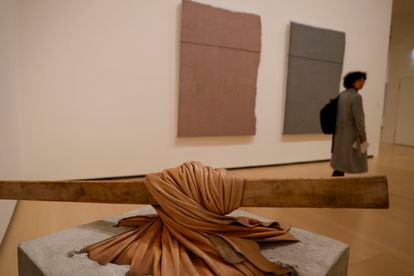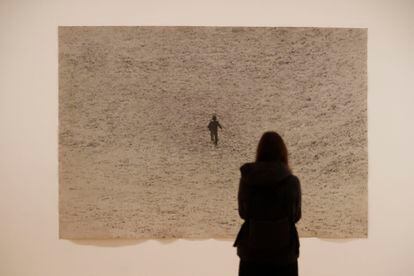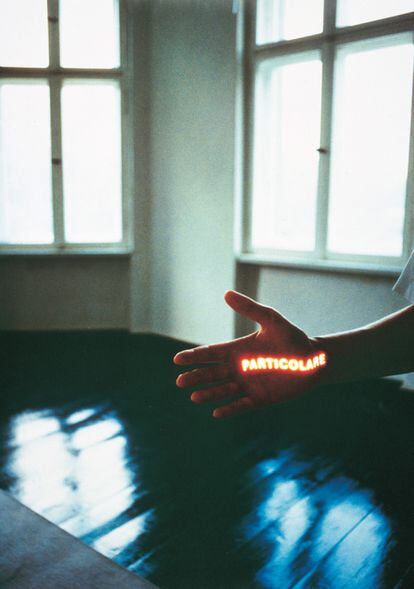Aristotle wrote in Metaphysics that “the beginning of all knowledge is admiration at the fact that things are what they are.” All the work of the Italian artist Giovanni Anselmo (Borgofranco d'Ivrea, 1934-Turin, 2023), to whom from today until May 14 the Guggenheim Museum Bilbao dedicates a major retrospective titled beyond the horizonpart of his amazement at energy: at the fact that energy this, given the fact that the energy be and that one is part of its infinity.
There is the prodigy, what makes authentic scientists, philosophers, poets, artists. The admiration, the astonishment, the genuine estrangement in the face of reality, and because of it, the fascination with it and the desire, the passion to know it and the action, the setting in motion to try, each one with their own way of approaching it, be it through science or through art.
Anselmo's moment of amazement comes one morning in 1965, while hiking with friends on the volcano on the Italian island of Stromboli, when he suddenly becomes aware of something singular: how he is at the top of the volcano and the sun is rising higher. Below, by the sea, the light does not project its shadow towards the ground but towards the sky, and in the infinity of space it is lost. The flight of his shadow makes evident to him what cannot be seen: that there is energy and that it is always in motion, and that that same thing, energy in permanent motion, is what we are. This epiphany leads him to the conviction that life-energy cannot be apprehended through representation, because it is never fixed and to represent it artistically is always to falsify it, so that what can be done—at least what he chooses— It is trying to present it, to make it present with your work.

LUIS TEJIDO (EFE)
This Guggenheim exhibition, Giovanni Anselmo. Beyond the horizon, It's a milestone. Because of his ambition, because such a comprehensive retrospective of his had never been undertaken, and also because of his situation, since the artist died just two months ago, on December 18. He was 89 years old and with him went one of the greats of the world. arte povera, label that undoubtedly gave him the projection that being included in a brilliant movement offers but from which, although he did not deny, he tried to remain discreetly apart. So the Guggenheim isn't just showing off Anselmo's production in a big way. It means much more than that. It is a tribute, yes, but it already had that meaning when the project was conceived and during its development, with Anselmo alive, weak but lucid, supervising from Italy. What has finally happened is that, without Anselmo, the exhibition takes on an even greater meaning: the Guggenheim immortalizes him. His work is immortalized. Humble and reserved, he would have abjured such bombastic words, but if he had to accept that something was immortalized, of course, he would accept that it was not himself but his work.
The curator of the exhibition, Gloria Moure, with whom he worked since the early nineties and had his first major exhibition in Spain (Centro Galego de Arte Contemporánea, 1995), remembers that in recent weeks, when trying to keep the artist involved and active , informing him of the details of the assembly, the catalog and so on, Anselmo only repeated: “What matters now is the work. The rest is superfluous. I do not matter”. Moure often traveled to Turin and together they thought about how to organize the exhibition. They used models of the rooms that the museum created expressly and mailed to the artist. They even made miniatures of the works to better visualize the assembly. When the commissioner arrived, Anselmo's room became a mess of models. “It seemed like we were playing house,” Moure jokes.
His work, Anselmo explained on different occasions, was his life.
Not in the cheesy and banal sense. For him it was not a way of speaking. For him it was not a metaphor, in fact the word metaphor made him nervous because it is a word that in itself moves, that leaves the place, the present. He meant it in a literal, pure, metaphysical sense. His work, which was his artistic relationship with energy, was his life, his existence and his self were nothing other than what he it happened in his works and – by extension – what happened, in a given space, between his works and the spectators, who become participants in the work, even being the work itself, as elements of the situation of energy.
And what happens in his works: what happens, for example, is the tension of a cable that holds a very heavy stone on a wall and the gravity that pulls the stone downwards; the lettuce trapped between two stones by a cable and its organic, energetic deterioration, which causes it to lose volume and progressively unbalance the whole until it collapses; the 300 million year old anthracite boulder subjected to the heat of a light bulb whose negligible energy, whose ridiculous heat force could nevertheless become significant, and return the boulder to its state prior to fossilization, if one waits long enough : geological time.
These sculptural configurations, at once plastic, conceptual, poetic and with a delicate sense of humor, constituted Giovanni Anselmo's being to the extent that he identified, as an artist, being with doing. He said in 1969: “I, the world, things, life, do not go beyond being situations of energy and the question lies precisely in not crystallizing such situations, but in keeping them open and alive based on our living.” Life as a holistic synthesis of consciousness and action that ultimately can only be realized through particular decision: “Given that energy exists under the most varied appearances or situations, the need arises for the most absolute freedom of choice or of materials use”. When Anselmo talks about choosing materials, we can read—just as—choosing what we decide to do with our lives. He is an artist at the antipodes of theorizing whose work is a deep existential theory.

Doing and being are the same thing for Anselm, and in that, naturally, without discursive intention, he connects with the Greek conception of poiesis, which is at the same time a know-how, a know-how to contemplate and a know-how to act. In that sense, Moure points out, in his work the poetic is political. It is a radical position to take.
The title of the show, Beyond the horizon, dialogues with the breaking of limits that Anselmo carried out in harmony with his generation of the sixties, both in Italy and internationally, a time of paradigm changes and creative expansion: Anselmo poses, never explicitly, the challenge of the traditional limits of representation artistic: what is a painting?, what is sculpture?; the challenge of the limits of the museum-space, while the lines of force and movement of its pieces cross, invisible, its walls; the challenge of the limits of perception and the same limits of being-energy. Title beyond the horizon It indicates this breaking of limits and, also, is a sign that indicates, already assuming the historiographical point of view, the direction of Anselm's work, and even more so now: posterity.
Through four rooms of the Frank Gehry museum—a great container for an artist so sober and light on luggage, for a containment engineer—almost fifty pieces are displayed.
It begins with the photograph taken of Anselmo at the top of Stromboli at the moment of his phenomenological epiphany. The slide has been projected on a wall next to the entrance door of the first room. It opens the exhibition and at the same time remains outside of it, a decision consistent with what the artist said about this image: that it was not a work in itself; The work, he emphasized, was what happened “at that precise moment.” The image, thus, remains in an attractive categorical limbo, between souvenir and work of art.
Works in the strict sense are everything else that appears once you pass the door. Almost fifty pieces. Among them the most notable of its moderate productive corpus, such as lettuce —Untitled (structure that eats)—, Torsion, a piece of iron trapp
ed by a twisted cloth—one of whose versions fetched six million euros at auction a few years ago—or Particular, another of his classics in which he projects the particular word onto insignificant points of space—a wall, a spectator's pants as he approaches the beam of light—and whose insignificance is suddenly revealed to be immeasurable when pointed out by the artist as an event in the museum space: it is its way of supporting and suggesting that particularity is, in dialectical terms, as necessary as totality.

Closes with the monumental While towards the sea the color lifts the stone, where a set of 24 stones hangs from the wall, in pairs and supported by sliding knots of steel cable. Below, a rectangle of ultramarine blue, whose visual effect is that of a perfect passage to infinity, and what great joy if that were death, the beyond: a rectangle of ultramarine color: nothing more than that, the color oltramare. Although all the stone pieces in the exhibition connect with the atavistic stone culture in the Basque Country, in this one the connection is greater because the work has been adapted with limestone from a local quarry.
Furthermore, both in this piece and in others, the presence of such heavy stones suspended from the wall in an improbable, prodigious way, refers to the prodigious Basque stone lifters or harrijasoztailes, a sport often belittled, as an expression of brute force, and that would surely have left Giovanni Anselmo speechless, who, otherwise, dedicated his entire life to doing the same and for whom strength or energy was the most beautiful and incomparable.
The historic lifter Iñaki Perurena, also an actor, rancher, sculptor and poet, already said in an interview: “A harrijasoztaile It's more than we think.”
With this exhibition, the Guggenheim Bilbao invites you to a unique experience. Only it is an experience that represents an enormous challenge: being able to pay attention. Every work by Anselmo, whether more or less accessible at first glance, requires an action as small as it is capital: stopping to look. Really look. Open to the possibility of wonder and estrangement. Understand that a lettuce, a stone or a piece of iron located in space, situated with us in space, it is an event. “His art asks you to make the effort to go beyond what you see, beyond simple appearance. You can walk around here and see nothing, or you can see a lot. He pushes you to feel and reflect, but he never imposes himself,” says Moure. The energy circuits that Anselmo creates, ultimately, require one last factor: our perceptive energy, the assumption and implementation of our natural poetic power, our desire.
All the culture that goes with you awaits you here.
Subscribe
Babelia
The literary news analyzed by the best critics in our weekly newsletter
RECEIVE IT
Subscribe to continue reading
Read without limits
_
#Guggenheim #Bilbao #immortalizes #Giovanni #Anselmo #poet #energy
